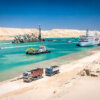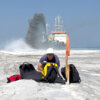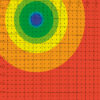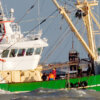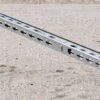Morphological and environmental data relate to sediment rate of the soil-water mixture, turbidity, dissolved oxygen and total suspended solids (TSS).
The most important morphological and environmental data relate to:
- Sediment transport;
- Turbidity;
- Solids (TSS);
- Dissolved oxygen;
- Contaminants;
- Other physical, chemical and biological indicators.
Sediment transport
Dredging and reclamation works can trigger erosion or sedimentation of certain specific areas. To study these phenomena, a combination of information is required, including:
- Bathymetrical;
- Hydraulic;
- Meteorological; and
- Geotechnical data.
Since the impact zone can potentially be much larger than the actual dredge or reclamation area, the extent of the area for which data has to be collected can also be much larger.
These data may be used to make a physical or numerical model of the vicinity of the fill area and or the borrow area in order to determine the impact of the future project on the present morphological regime. They may also be used as input for an environmental impact assessment.
Turbidity
The turbidity of water is defined as the degree to which water contains particles that cause cloudiness or backscattering and the extinction of light. High turbidity levels (in excess of the natural water turbidity) generally occur in the vicinity of dredging and reclamation projects caused by the release of organic and inorganic solids (i.e., fine sediment fractions) into the water column.
One of the main areas of environmental concern is the effect of elevated levels of suspended sediment on the natural environment. Suspended sediments introduced in the marine environment limit the transparency of the water and prevent light from shining through. As such, suspended sediments will affect the primary processes in the water body. Furthermore, settling particles can potentially result in the smothering of sensitive habitats like seagrass and coral. Quite often, dredging and reclamation works have to be executed within stringent criteria.
Total Suspended Solids (TSS)
As a result of the presence of suspended particles, water will lose its transparency. Increased turbidity levels will alter local primary photosynthesis processes. Consequently, the oxygen and temperature levels of a water body may be affected.
Because the amount of suspended particles corresponds to the intensity of scattered light, a turbidity measurement can quickly provide an estimate of the amount of suspended solids in a water body.
Background turbidity data relate to the measurement of the concentration levels of suspended material in the water column prior to dredging.
Dissolved oxygen
Organic matter released or stirred up during dredging and reclamation operations will reduce the levels of dissolved oxygen in a water body as a result of aerobic oxidation. Because of its importance to all life forms, a shortage of oxygen may have serious implications for the natural environment. Consequently, dredging operations are constantly measuring for increases in the release of organic matter.
Contaminants
In case contaminated soils are to be dredged, detailed analyses of contaminants such as heavy metals and PCBs are required.
Additional parameters
The complexity with respect to water quality is reflected in the many types of physical, chemical and biological indicators. Depending on specific project requirements, information about a wide variation of additional parameters may be required in order to describe the state of and the effect on the water quality. Simple measurements can be made on-site in direct contact with the water source. These include:
- temperature;
- dissolved oxygen;
- conductivity,
- alkalinity (pH); and
- ammonia.
More complex measurements, such as toxic contaminants and the presence of micro-organisms, may require water sampling followed by an analysis in the laboratory.



